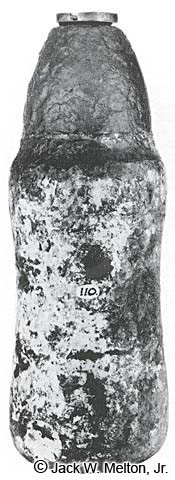| This projectile consists of a thin cast iron shell enclosing forty-two
segment-shaped pieces of cast iron, built up so as to form a cylindrical center cavity.
The exterior of the shell is thinly coated with lead, which was allowed to percolate among
the segments so as to fill up the interstices; the central cavity was kept open by a steel
rod. The projectile was so compact that it could be fired through six feet of hard timber,
yet its resistance to a bursting charge was so small that less than one ounce of powder
was required to burst it. The Confederates had the exclusive use of this Armstrong-pattern
projectile; it saw no service in the Federal forces. The Confederates fired one projectile
of this pattern into General Abbot's Dutch Gap batteries in 1864. Abbot stated: "Had
it not been for this circumstance, I should have supposed that none of the ordnance of
this gun-maker was ever used by either army in Virginia." Ten of the unfired
Armstrong projectiles were recovered in a Confederate fort at High Bridge, Virginia. |
